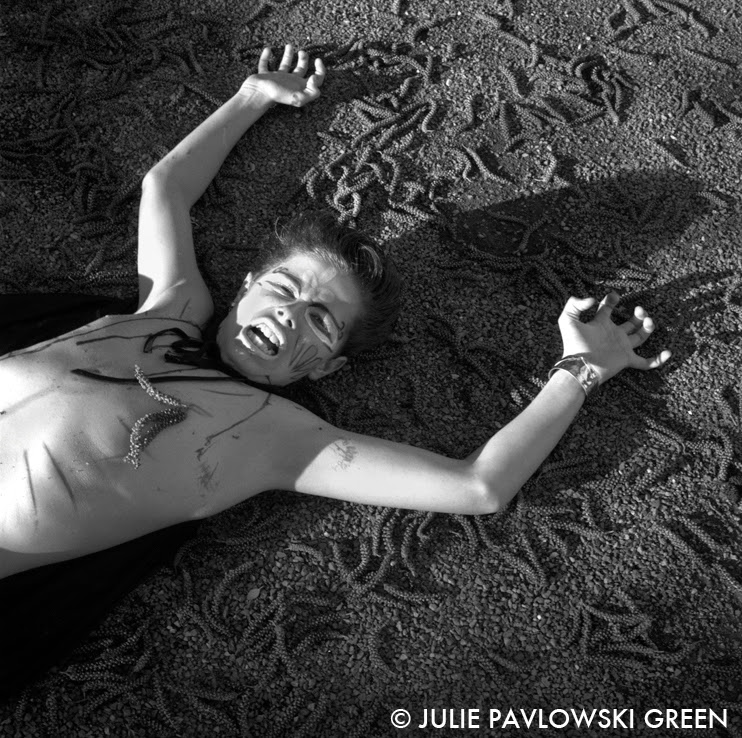¡ Vampyre ¡
This article originally ran in March 2013 to celebrate Easter. As Samhain is upon us, I thought it would be timely to run it again. We will return next month with another installment of "A Day In The Life Of a Rock n' Roller".
Happy Halloween!
Julie Pavlowski Green
October 25, 2014
The more I dig into the idea of the collective psyche, the more I realize how little we verbally discuss the issues of death and dying. We are more comfortable with visually seeing death than we are actually discussing it. Just ask yourself why we all slow down for a traffic accident... I believe this suppression of vocalizing our feelings on the subject finds a way to express itself in our fascination with fictitious characters we have conjured up to help us deal with these internal feelings. Perhaps its not just our American culture but the Modern World which has since shed their folkloric traditions, that helped to allay the fears of death, decay and denied desires, and replaced them with these fictional archetypes.
What a rich collective imagination we have! Our ancestors created these stories to placate their fears of the unknown. The fear of revenants has existed since time began, most likely due to the lack of knowledge and control over disease and the visual manifestations of decay in the human body after death. Man has always needed to explain and categorize in order to comprehend and it is through our ancient customs, rituals and folklore that Man has interpreted the world around him.
The sucking of blood from a virgin is not exactly without sexual overtones. The draining of fluids seems to me an obvious symbolic reference to semen. Oral sadism that evolved into the basis of "vampiric action", releases the repressed expression of certain sexual desires. No wonder Dracula has been rendered in over 750 movies since the turn of the 20th Century! This monster's role in different societies has changed, as we as a people have changed. From religious associations to more of a sexual orientation. Sexually repressed eroticism is something more common than we probably would like to discuss and manifests itself in the form of the undead coming to drink your blood!
We all have encountered someone that makes us feel drained and exhausted. Every time we interact with them, it feels as if our vital energy is literally sucked out of us. (Hopping Corpses anyone?) I call them energy vampires. What they really are, are people suffering from a narcissistic behavioral disorder. The can suck the air right out of the room! This predatory personality is a parasite on the life energy of others. With an inflated concept of themselves, they seek constant praise and admiration from others around them. In Christopher Leasch's book The Culture of Narcissism, he explored the acceleration of moral self absorption that is emerging from the modernization and secularization of our Modern World.
The conscious and unconscious metaphors surrounding the myth of the Vampire are rich in allegory. From sleeping during the conscious daytime and subsequent death upon the exposure to light, to the enclosure of the symbolic unconsciousness represented by the coffin and the Vampire's nocturnal excursions, the desire to represent this character in art, film and fiction is too delicious to not take a bite! The creature oozes with the kind of symbolism we artists desire to represent and reinterpret in our work.
John Polidori's The Vampyre (1819) was the first popular fictitious account of our undead friend, in the form of Lord Ruthven. Our course Bram Stoker's Dracula (1897), has become the pre-eminent Vampire novel of all time. But it wasn't until film took a hold of this richly decorated character that our nightmares were truly animated. In F.W. Murnau's ground breaking silent file, Nosferatu (1922), the ghoul is a visual feast of terror. My personal favorites come later in the form of Béla Lagosi's interpretation in Universal Picture's 1931 Dracula and of course the entire Hammer Horror series which I grew up watching every Saturday night on Creature Feature. (Thank you Bob Wilkins!)
The haunting images of a little boy playing dress up as a Vampire seemed to hit the right chord. The darkness dappled with hints of light showing us a little more detail of his world of make believe, helps us to understand our own psyche and our hidden, dark desires that manifest themselves in different ways. A painted face, some fake blood, a cape and a kitchen towel used for a loin cloth are all you need to face the unknown and shed some light on the darkness within.






Comments
Post a Comment